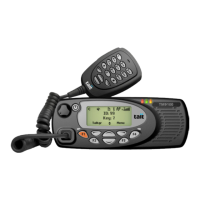78 Circuit Descriptions TM9100 Service Manual
© Tait Electronics Limited August 2005
The sections of the circuitry concerned with these functions are described
below.
Audio Signal
for Speaker
The audio signal for the speaker is generated by IC204 (VOUTAUXP ball).
This signal is post-volume-control and has a pre-emphasized frequency
response. The signal is then processed by R218, R217 and C231
(50W/40W radios) or C205 (25W radios) to restore a flat frequency
response and reduce the signal level to that required by the audio power
amplifier.
Summing Circuit The top of C231 (50W/40W radios) or C205 (25W radios) is where side
tones are summed in and the
CDC RX AUD signal is obtained. C201 and R211
pre-emphasize and attenuate the side-tone signal to give a flat side-tone
frequency response and reduce the input to an appropriate level.
Buffer Amplifier IC201 (pins 8 to 10) amplifies the signal at the top of C231 (50W/40W
radios) or C205 (25W radios) by 19dB and drives the
CDC RX AUD system
interface line via C212 and R225. The capacitor C212 provides AC output
coupling and R225 ensures stability. The DC bias for this amplifier is
derived from IC204.
Audio Power
Amplifier
The signal at the top of C231 (50W/40W radios) or C205 (25W radios) is
fed via C204 to the audio power amplifier IC202. IC202 has 46dB of gain
and a differential output configuration. C209, C211, R252 and R253
ensure stability of the amplifier at high frequencies. When operational, the
output bias voltage for IC202 is approximately half the radio supply voltage.
When not operational, the output becomes high impedance.
Control of Audio
Power Amplifier
Power up, power down, and muting of IC202 is controlled by two signals
from the digital section,
DIG AUD PA EN1 and DIG AUD PA EN2. The network
consisting of Q200, Q201, R200 to R206, R210 and R250 converts the
two digital signals to the single three-level analog signal required by IC202.
Microphone Signals There are two microphone source signals:
■ ITF AUX MIC AUD from auxiliary or internal options connector
■ ITF CH MIC AUD from control head
The biasing for electret microphones is provided by a filtered 3.0V supply
via R226 and R227. The components R209 and C202 provide the supply
filtering. The microphone inputs to IC204 (
VINAUXP, VINAUXN, VINNORP, and
VINNORN balls) are differential. The negative inputs are decoupled to the
filtered 3.0V supply by C215 and C216. The positive inputs are biased to
approximately 1.5 V by R229, R232, R230 and R233. AC coupling and
DC input protection is provided by C213 and C214.
Auxiliary Audio
Input
The auxiliary audio input signal ITF AUD TAP IN is DC-coupled to the ADC
input of IC205. R241 combined with internal clamping diodes in IC205
provide DC protection for the ADC input. IC205 provides the input biasing
of approximately 1.5V.

